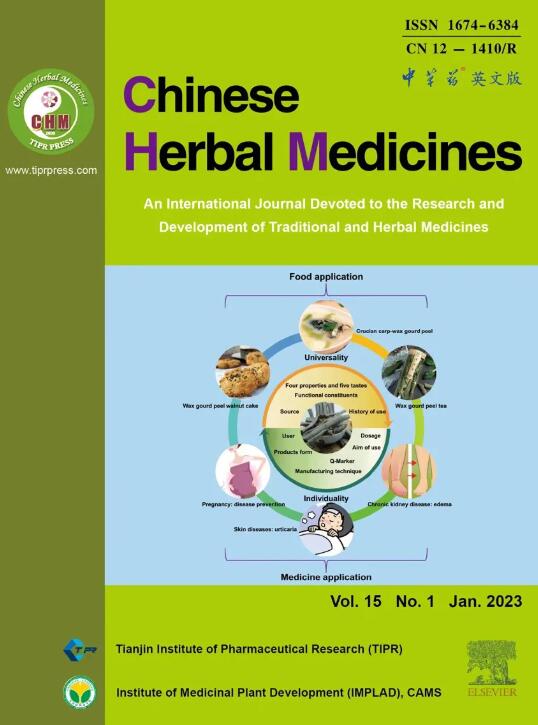Amelioration of atherosclerotic complications and dyslipidemia by verbascoside-enriched fraction of Clerodendrum glandulosum leaves targeting LDL-R and LXR-mediated reverse cholesterol transport
IF 4.7
4区 医学
Q1 CHEMISTRY, MEDICINAL
引用次数: 0
Abstract
Objective
Clerodendrum glandulosum is widely used in traditional Chinese and Indian systems of medicine for conditions like hypertension and diabetes. While various pharmacological benefits have been reported, research on its anti-atherosclerotic properties remains limited. Atherosclerosis (AS) is a chronic cardiovascular disease linked to dyslipidemia (DLD) and inflammation. This study aims to identify the bioactive fraction from C. glandulosum extract, evaluate its potential against AS and DLD, and explore the molecular mechanisms of cholesterol metabolism.
Methods
Bioactivity-guided fractionation was employed to investigate the bioactivity of C. glandulosum by screening biochemical enzyme inhibitory potential. The active fraction was subjected to in vitro testing to assess the anti-inflammatory and anti-adhesion properties. The fraction was administered at 50 and 100 mg/kg per os (p.o.) to cholesterol-cholic acid-thiouracil (CCT) diet-induced atherosclerotic Wistar rats. Changes in lipid and antioxidant profiles, inflammatory markers, and cholesterol metabolism pathways were assessed using Western blotting. Histopathological analyses of the aorta, liver, heart, and kidneys were also conducted. Molecular docking was conducted for the verbascoside (VER) and the standard statin, atorvastatin (ATS), for their binding capabilities with the molecular targets considered in this study.
Results
Bioactivity-guided fractionation and screening revealed that ethyl acetate fraction (EAF) contained VER as the principal phytoconstituent. EAF exhibited potent enzyme inhibitory activity, with IC50 values of 1.059 mg/mL for pancreatic lipase and 22.48 µg/mL for α-glucosidase. In vitro analysis revealed that EAF significantly lowered cell-to-cell adhesion to 0.57 folds from 2.5 folds in the disease control and normalized the inflammatory cytokines. In CCT-diet-induced rats, elevated serum cholesterol and low-density lipoproteins (LDL) levels (92.1 mg/dL and 78.49 mg/dL, respectively) were reduced to 63.52 mg/dL and 58.51 mg/dL with EAF at 100 mg/kg. EAF at 100 mg/kg reduced oxidized LDL to 53.63 ng/mL compared to 157.1 ng/mL in CCT-diet-fed rats. EAF also restored antioxidant activity by increasing superoxide dismutase and catalase levels to 73.78 and 17.72 U/mg protein, respectively, compared to 42.22 and 9.62 U/mg protein in CCT-diet-fed rats. EAF restored inflammatory cytokines to normal levels. Histological analyses validated the protective benefits of EAF supplementation for the structural integrity of the aorta, liver, heart, and kidney tissues. Western blotting analysis of liver tissues revealed changes in the cholesterol metabolic pathway by upregulating peroxisome proliferator-activated receptor gamma (PPARγ)/liver X receptor alpha (LXRα)/adenosine triphosphate-binding cassette sub-family G member 1 (ABCG1) and low-density lipoprotein receptor (LDL-R) expression. Unlike ATS, molecular docking analyses indicated strong interactions between VER and molecular targets.
Conclusion
EAF prevented DLD and AS by reverse cholesterol transport via the PPARγ/LXRα/ABCG1 pathway, offering potential therapeutic benefits for cardiovascular health.
以LDL-R和lxr介导的胆固醇逆向转运为靶点,富含毛茛苷的毛茛叶提取物改善动脉粥样硬化并发症和血脂异常
目的:在中国和印度的传统医学体系中,腺棘豆被广泛用于治疗高血压和糖尿病等疾病。虽然各种药理作用已被报道,但其抗动脉粥样硬化特性的研究仍然有限。动脉粥样硬化(AS)是一种与血脂异常(DLD)和炎症相关的慢性心血管疾病。本研究旨在鉴定腺体草提取物的生物活性部位,评估其抗AS和DLD的潜力,并探讨其胆固醇代谢的分子机制。方法采用生物活性引导分选法,通过筛选生化酶抑制电位,研究腺棘草的生物活性。对活性部位进行体外抗炎、抗粘连试验。以50和100 mg/kg / os (p.o.)给药于胆固醇-胆酸-硫脲嘧啶(CCT)饮食诱导的动脉粥样硬化Wistar大鼠。脂质和抗氧化谱、炎症标志物和胆固醇代谢途径的变化使用Western blotting进行评估。对主动脉、肝脏、心脏和肾脏也进行了组织病理学分析。我们对毛蕊花苷(VER)和标准他汀类药物阿托伐他汀(ATS)进行了分子对接,以确定它们与本研究考虑的分子靶点的结合能力。结果生物活性引导分离和筛选表明,乙酸乙酯部分(EAF)的主要植物成分为VER。EAF对胰脂肪酶的IC50值为1.059 mg/mL,对α-葡萄糖苷酶的IC50值为22.48µg/mL。体外分析显示,EAF显著降低了细胞间粘附,从疾病对照组的2.5倍降至0.57倍,并使炎症细胞因子正常化。在cct饮食诱导的大鼠中,EAF在100 mg/kg时将血清胆固醇和低密度脂蛋白(LDL)水平分别从92.1 mg/dL和78.49 mg/dL降至63.52 mg/dL和58.51 mg/dL。100 mg/kg EAF将氧化LDL降至53.63 ng/mL,而cct饮食喂养的大鼠为157.1 ng/mL。EAF还通过将超氧化物歧化酶和过氧化氢酶水平分别提高到73.78和17.72 U/mg蛋白,而cct饮食喂养的大鼠的超氧化物歧化酶和过氧化氢酶水平分别为42.22和9.62 U/mg蛋白,从而恢复抗氧化活性。EAF使炎症细胞因子恢复到正常水平。组织学分析证实了补充EAF对主动脉、肝脏、心脏和肾脏组织结构完整性的保护作用。肝组织Western blotting分析显示,胆固醇代谢途径通过上调过氧化物酶体增殖物激活受体γ (PPARγ)/肝脏X受体α (LXRα)/三磷酸腺苷结合盒亚家族G成员1 (ABCG1)和低密度脂蛋白受体(LDL-R)表达而发生变化。与ATS不同,分子对接分析表明VER与分子靶点之间存在很强的相互作用。结论eaf通过PPARγ/LXRα/ABCG1途径逆转胆固醇转运,预防DLD和AS,对心血管健康具有潜在的治疗作用。
本文章由计算机程序翻译,如有差异,请以英文原文为准。
求助全文
约1分钟内获得全文
求助全文
来源期刊

Chinese Herbal Medicines
CHEMISTRY, MEDICINAL-
CiteScore
4.40
自引率
5.30%
发文量
629
审稿时长
10 weeks
期刊介绍:
Chinese Herbal Medicines is intended to disseminate the latest developments and research progress in traditional and herbal medical sciences to researchers, practitioners, academics and administrators worldwide in the field of traditional and herbal medicines. The journal's international coverage ensures that research and progress from all regions of the world are widely included.
CHM is a core journal of Chinese science and technology. The journal entered into the ESCI database in 2017, and then was included in PMC, Scopus and other important international search systems. In 2019, CHM was successfully selected for the “China Science and Technology Journal Excellence Action Plan” project, which has markedly improved its international influence and industry popularity. CHM obtained the first impact factor of 3.8 in Journal Citation Reports (JCR) in 2023.
 求助内容:
求助内容: 应助结果提醒方式:
应助结果提醒方式:


